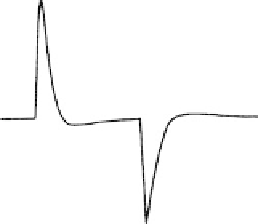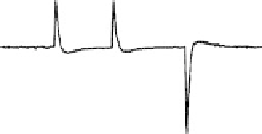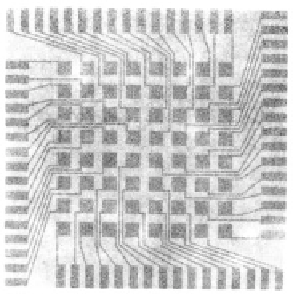Biomedical Engineering Reference
In-Depth Information
1
23
4
h
6
6
5
100 ms
A
On
Light
Off
(A)
(C)
0.5 s
On
Off
On
Time
(B)
(D)
FIGURE 15.20
A motion-sensitive sensor array based on the AC photoelectric effect of bR. (A) The cross-section of a photocell,
formed by immobilizing bR on a transparent electrode, is shown: 1, SnO
2
transparent conductive layer; 2, purple
membrane LB film (typically six to ten layers) 3, aqueous electrolyte gel layer (200
m thick); 4, Au layer (<1000 Å)
as counter-electrode; 5, Teflon ring space; 6, glass substrate. (B) ITO (indium tin oxide) electrode was patterned with
64 pixels for image-sensing. Pixels of ITO (2.5 mm by 2.5 mm, 1000 Å thick transparent layer) form a two-dimen-
sional array on a glass plate. Each pixel has a separate wire leading to the four edge terminals along the sides for
interfacing with an amplifier circuit. (C) The photocurrent is generated in each pixel by a square light pulse of about
200-ms duration. The positive spike (“on” response) and the negative spike (“off” response) are main characteris-
tics of the response of a linear high-pass
RC
filter to a long square pulse of applied current (see also Figure 15.4).
The linear high-pass filter is formed by the irreducible equivalent circuit shown in Figure 15.5. (D) Photoresponses
to step illumination shows the differential responsivity, which is also a characteristic of a linear high-pass
RC
filter:
the amplitude of the photosignal transient is proportional to the magnitude of step illumination. (From Miyasaka,
T., Koyama, K., Itoh, I. (1992). Quantum conversion and image detection by a bacteriorhodopsin-based artificial
photoreceptor.
Science
255:342-344. (A, B, C), and Miyasaka, T., Koyama, K. (1993). Image sensing and processing
by a bacteriorhodopsin-based artificial photoreceptor.
Appl. Optics
32:6371-6379. (D))
of a linear high-pass
RC
filter. The photocurrent response is therefore the manifestation
of the AC photoelectric effect of bR (see Figure 15.4). The expected linearity of the high-
pass filter response is demonstrated in Figure 15.20D, which shows that the amplitude of
the AC transients are proportional to the change of the level of input illumination rather
than the level per se (see also Wang et al. [97]). The capability of this photosensor to detect
motion relies on differential responsivity as well as the linearity of responses.
Additional prototypes, which were based on the AC photoelectric effect include an arti-
ficial retina developed by Birge and Chen [98], an artificial neural network developed by







